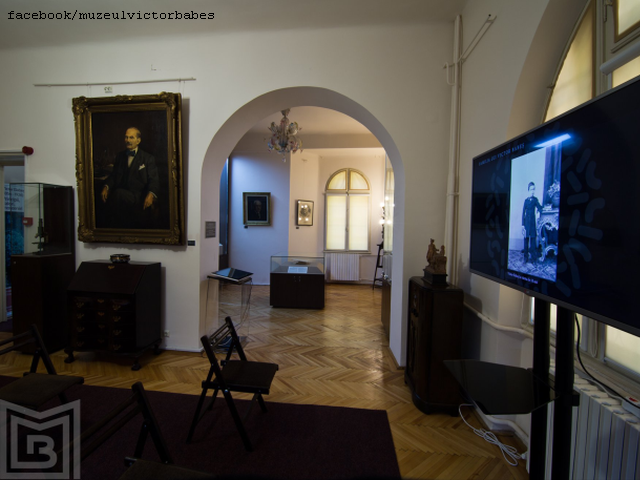Victor Babeș Memorial House in Bucharest
The house of the diplomat Mircea Babeș, the son of the famous Romanian scientist and bacteriologist Victor Babeș, is now the Victor Babes Memorial House

Christine Leșcu, 28.11.2020, 14:00
In the north of Bucharest, on the then outskirts of the city, there emerged, in the inter-war period, a stylish residential district built for the then middle class. This is the place where the diplomat Mircea Babeș, the son of the famous Romanian scientist and bacteriologist Victor Babeș had his house built. The house is now a Memorial Museum to honor Victor Babeș. Born in Vienna in 1854 to a Romanian father from the Romanian region of Banat, in the southwest, and to an Austrian mother, Victor Babeș became famous at the age of 30, as a co-author of the first treaty on bacteriology in the world.
Oana Panait is a museum curator with the Victor Babeș Museum within the Bucharest History Museum and she will tell us more about the scientific activity of Victor Babeș: “He published more than 1,300 works, which are critical for the infectious diseases domain. But the most important of all is the treaty on bacteriology issued in Paris when the young Victor Babeș had not turned 31 yet. He published the work ‘Bacteria and their role in the anatomy and histology of infectious diseases written in 1885 together with the French scholar André Victor Cornil. The treaty set the basis of bacteriology as a science. It is the first treaty on bacteriology in the world and comprises about all that the scientific world needs to know about bacteria. Louis Pasteur himself noticed the contribution of Victor Babeș and proposed him for the most prestigious prize granted by the French Academy of Sciences in Paris, the Montyon Prize. After receiving the prize, Victor Babeș became famous all over the world and was invited by Robert Koch to work in Berlin although Louis Pasteur wanted to keep him in Paris. Fribourg University from Switzerland also invited Victor Babeș to teach there. Even the US invited the Romanian scientist to go there and work as a researcher. As he was struggling with indecision, Victor Babeș received a letter from Dimitrie Sturdza, the Romanian minister of culture at the time, in which he was invited to Bucharest. This is how Victor Babeș reached Bucharest, where he was appointed head of a new institute of bacteriology. Besides benefiting from laboratories and an amphitheater for teaching, he and his family were offered permanent residence. Therefore, after 1886, Victor Babeș and his wife moved to Bucharest. He also taught at the medicine faculty in Cluj, whose leadership decided to honor the great scientist by naming it Babeș-Bolyai University.
For the entire period spent in Bucharest, Victor Babeș lived at the Institute of Bacteriology where he died on October 18, 1926 during the night. He had previously felt sick when working at his microscope in the lab. Subsequently, this microscope was exhibited in his sons house, which the scientist never visited, and which became a museum in the 1950s.
Here is Oana Panait with more details: “The house of Mircea Babeș was turned into a museum in two stages. The first stage occurred in October 1956. One year before, Constantin Parhon, an epidemiologist who was the disciple of Victor Babeș, suggested to Mircea Babeș that the ground floor of the house be turned into a museum, while the son of the Romanian scientist and his wife were to live upstairs. People often ask if, in 1929, Mircea Babeș, who had returned from a diplomatic mission in Ottawa, had considered, even for a second, turning the house into a museum. But as far as I know, and from what I found out in his memoirs, he never had that intention. As of 1956, the ground floor of the house became a museum, with Mircea being a curator until his death in 1968. His widow, Mrs. Sofia Babeș, continued to live upstairs. In 1986, Sofia Babeș made a testamentary donation under which the entire house became a museum, and was to be included in the patrimony of the Bucharest city hall.
Today, those who visit the house of Mircea Babeș and his wife Sofia, will discover objects that marked the life and activity of the famous Romanian scientist Victor Babeș. Oana Panait is back at the microphone with more: “The villa was built in 1929 after the blueprints of some Viennese architects, in an eclectic style with neo-Romanian tendencies, in the style of the Romanian architect who created this style, Ion Mincu. It is a single-storey house. In 1929 Mircea Babeș brought from his fathers institute several objects which he would showcase at the villas ground floor. Those who visit the museum can see these objects – furniture and decorative objects – dating back to the late 19th century. They will admire the favorite mahogany desk of Victor Babeș, which was made in Munich, and a very beautiful table made of Sevres porcelain with gilded bronze decorations. This table has a very beautiful story. It was bought by Victor Babeș and his wife from Paris in 1912 after he had published a book on rabies. With the money earned from the sale of this book, which had a great success all over the world, the scientist bought this small Sevres porcelain table with gilded bronze decorations. Visitors of the museum can also admire numerous decorations, medals and insignia which the famous Romanian scientist Victor Babeș received from the world scientific community. Victor Babeș also received various decorations from the Royal House of Romania. Even Queen Elisabeth, the wife of King Carol I, offered Victor Babeș several medals.
Recently restored, the Victor Babeș Museum in Bucharest was re-opened for the public at large, with a section dedicated to children, to familiarize them with the sciences. (tr. L. Simion)






























